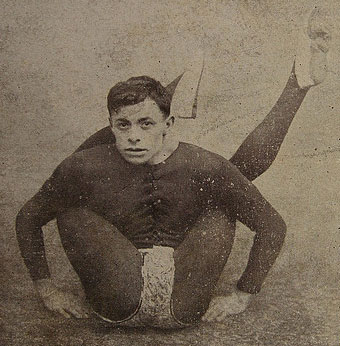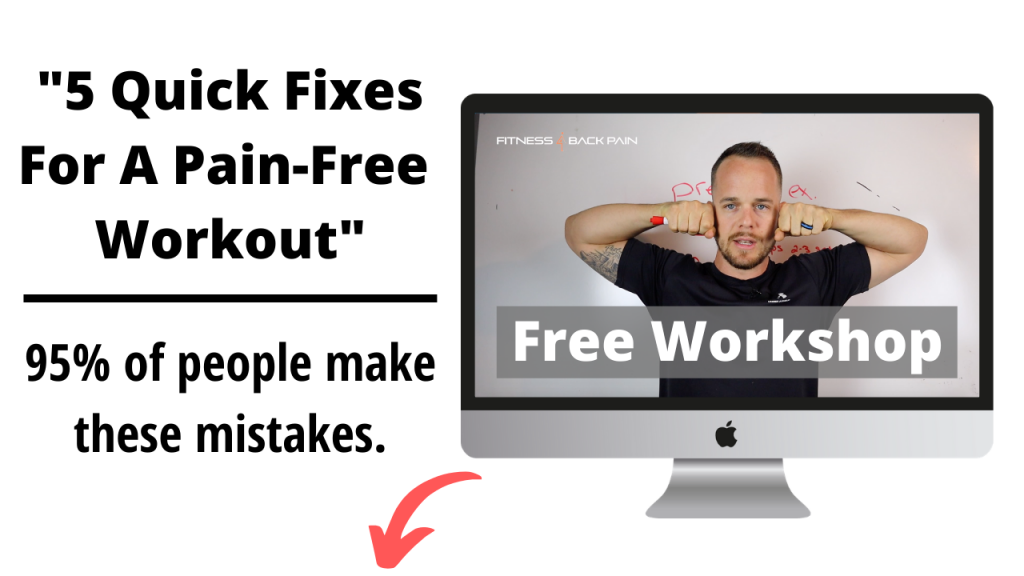We talk about sitting a lot on this blog and how terrible it is for anyone currently dealing with lower back pain. What I want to focus on today is how your lack of hip mobility could be another key factor in your back pain relief plan. The more you sit, the more imbalances you could develop in the muscular system within the hip which could result in an over worked lower back. I am a firm believer in making sure your hips are as mobile and freely moving as they should be.

My shot gun answer to the question “Why is sitting bad for the back” would be because of dormant glutes and shortened anterior hip muscles such as the hip flexors. With all the sitting we’re doing, our hips are having to adjust and overcompensate for poorly active muscles. Sitting isn’t the cause of all back pain but it can have a direct relation to a poorly mobile hip. If this is you, this post will change your life! We are here today to squash this issue once and for all.
I emphasized as they should be for one reason and one reason only. You cannot compare your hip range of motion with the person beside you. Every body is designed differently and in order for you to do things right and not cause further harm is to focus and listen to how your body is responding. Your range of measuring when it come to whether or not you are actually tight or not will be similar to some people but don’t set your goals far above what your body is capable of doing in the first place!
We want enough range of motion to successfully execute our basic activities in life such as carrying grocery’s up stairs, lifting your kids or a barbell of the ground all while dealing with little to no pain.
Foam Rolling For Better Hip Mobility
Foam Rolling Your Iliotibial (IT) Band
I haven’t really dived into the “how to use” or “when and where” to use the foam roller when it comes to back pain, so for now, consider this your introductory course. I know for me personally there are three areas that I have had the most experience with myself along with assisting other in their own treatment. What I want to do is give you my top 3 foam rolling techniques to help improve your hip mobility. Remember this is just what I have found to work on me along with others I have worked with. Always proceed with caution and find out for yourself whether these moves are a good fit for you!
When trying to loosen and create better movement within the hips it’s key to work over a number of different areas. In this case we are going to hit the Iliotibial Band (ITB) first.
This is a piece of tissue that runs from your hip down to just below your knee. Often times when muscles like our Glute Medius decides to go dormant, the IT band has to pick up most of the slack. If you’re confident that you have an over wound IT band, check out the video below on how to treat it with a Foam Roller.
Note: Fast forward to about 1:10. He talks about the anatomy of the ITB during the first half.
Take action: Spend 1-2 Minutes doing this technique while slowly graduating from the basic stance to the more aggressive stance. Make sure you breathe deep and stay relaxed.
Foam Rolling Your Glutes
The second area of focus is going to be the glutes. The glutes are made up of 3 major parts the Glute Minimus , Glute Medius and Glute Maximus. All three are all stars when it comes to hip function when trying to prevent back pain. You can either have one of two issues. 1) Your glutes aren’t firing due to lack of muscle control and proper use OR 2) They are wound to tight. For the sake of this article we are going to talk about unwinding the glutes using the foam roller.
Check out this short video I put together on how I target my glutes in three sections.
Take Action: Spend 1-2 minutes on each butt cheek. Stay cool and collected and focus on those troubled areas within the glutes
Foam Rolling Your Inner Thighs
Oh the dreaded sweat meat. The inner thighs are probably hands down some of the most tender muscles on the body. The area as a whole is just super sensitive and since it never really gets any work they can get really tight. The inner thighs (also known as the ADductors) don’t get the attention they deserve. They are actually a rather large group of muscles that not only help stabilize the hip but assists in core stability and proper walking mechanics. This usually is not the sole reason but can have a large affect on the kinetic chain when it comes to back pain.
In this video I show you how to target the inner thighs without looking like a weirdo. Remember, the inner thigh is pretty sensitive and can be painful to roll, so take it slow and allow the muscles to relax and allow the roller to sink in.
Take Action: Spend a little extra time here at about 2 minutes each leg. Give a little more attention to the area closest to your knee and groin. Go slow and breathe through any knotted areas.
Trigger Release For Improved Hip Mobility
Trigger Release for Your Piriformis
The first and most common muscle I want you to focus on is the Piriformis. We don’t want to focus too much on stretching the muscle but getting it to relax and allow the muscle fibers to release. I found a great video that shows exactly what I do when I have been sitting for long periods of time or sense my hip getting tighter. Again, this is not a one stop shop for hip function, this is just another key piece to the puzzle! If you currently dealing with sever sciatica do NOT try to do this to relieve your pain. Get cleared by a doctor to perform this type of movement. One of my top ranked articles on this site talks specifically about foam rolling and trigger release for the Piriformis. Check it out here if your interested
Take Action: Spend two minutes straight on each Piriformis rotating in and out of trigger point compression and gentle rolling. Play with your leg position and don’t do anything that cause too much pain. Hold the trigger point for 30-45 seconds before moving. Trigger Release for Your Hip Flexors
The second key hip muscle group is what I refer to as the hip flexors. There are a number or different muscles that make up this group but to spare your brain from internally combusting lets just keep it at hip flexors. I talk a lot about the hip flexors and how they can become shortened over a long period of time from things like sitting too much, cycling or martial arts. As these muscles shorten your pelvis takes on an anterior tilt which puts a load on the lower back exaggerating any pain you currently have. One of the best ways to keep the muscle from become strained from over stretching it is to focus first on trigger release. Not only does this video show you one of the worlds deepest V-Neck Shirts ever warn by a man (he pulls it off though!), but it shows you exactly how to treat the hip flexor with a lacrosse ball.
Take Action: Spend two minutes straight on each Hip Flexor rotating in and out of trigger point compression and gentle rolling. Play with your leg position and don’t do anything that cause too much pain. Hold the trigger point for 30-45 seconds before moving.
Trigger Release For the Glutes
My final trigger point location I personally have found tons of relief and improved hip mobility from are the Glutes. You spent a little time foam rolling them above, now you’re going to get in a little deeper. This video is a “two for the price of one”. Skip ahead to the 1:00 mark and stay tuned after he talks about the glutes. He goes into another major muscle group that you can easily hit while working on the glutes.
Take Action: You can spend a little more time on this area. Minimum of 2 minutes each flute. Start on the larger portion and work your way into the deeper bellies of the muscles. Hold the trigger point for 30-45 seconds before moving.
When it comes to working on hip mobility it’s something you need to take one day at a time. Once you know that your hips are tight and are in dire need of some attention don’t be in a rush to mash them out. Take time to really understand the areas that are tight. Nobody will have the same issues which is why everything you see here needs to be applied only in a way that will benefit your specific situation.
One of the biggest issues I had was an over tight piriformis and dormant glute muscles. This caused a lot of hip and lower back pain. The doctor chalked it up as a disc issue and sent me on my way. I spent my time applying different techniques and experimenting on myself to come to where I am today. Just don’t be in a hurry and listen to your body. You want these movements to bring relief NOT further irritation.
Putting together all the pieces
Holy crap that’s a lot of info!! Well, my goal was for you to make it to this point and have a killer head start on seeing relief and improvement in your pain management. What I want to leave you with now is exactly the way I would implement everything you’ve learned today.
Step by Step:
-
Find out first what is tight and if your cleared for active recovery
-
Always start with foam rolling. It’s a great way to warm up the muscles and get the blood pumping (never roll your lower back though)
-
Do each foam rolling segment for 1-2 minutes (each leg)
-
The trigger release always follows the foam rolling.
-
Spend 1-2 minutes on each troubled area with your lacrosse ball or tennis ball
-
Repeat and focus on the areas that are the tightest. Breath deep and never tense your muscles
-
Finish your day with some Dr. Teals Epsom Salts. I love this stuff and it is my go to pain management solution!
Thanks for reading! Oh and I am looking to meet some new people who tend to sit too much! Tag a friend who you know is a pro sitter!!
If what you read today is worthy of your page, share it with your Facebook family!
TTYS,
William

